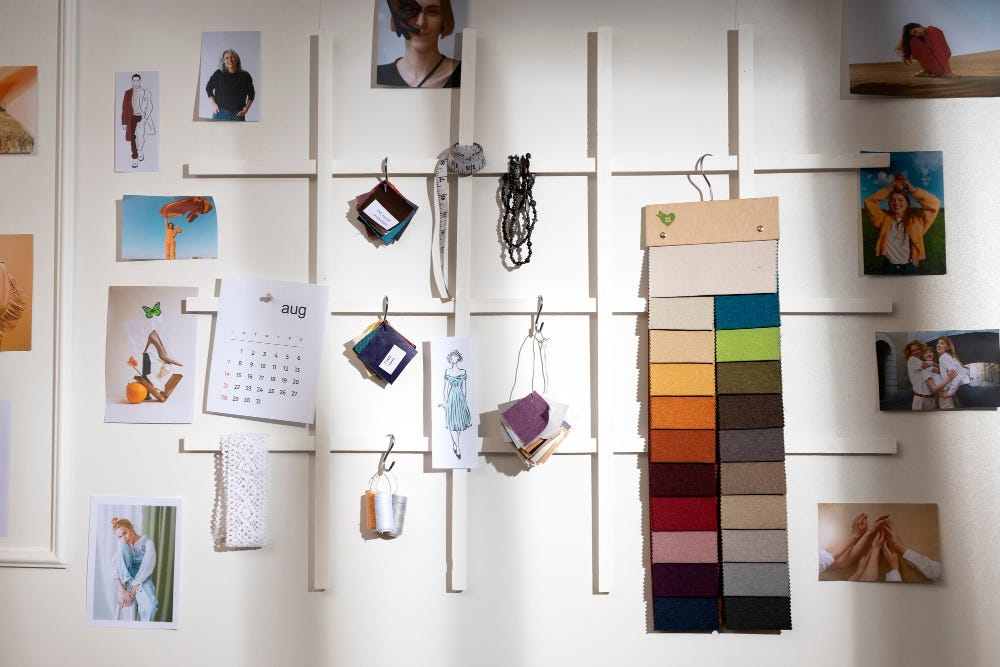Beyond Visual Stimulation
I've been watching designers struggle with AI, and it's not what you'd expect. The problem isn't that AI can't generate beautiful visuals—it's that most designers don't know how to think beyond the visual.
After years of observing design teams work, I've noticed a troubling pattern: we've become so visually stimulated, so dependent on mood boards and aesthetic references, that we've lost the ability to think contextually. But I'm starting to envision how RAG systems could fundamentally transform this limitation—if we're brave enough to build them properly.
The Mood Board Limitation
Walk into any design studio and you'll see them: walls covered in carefully curated mood boards, Pinterest collections organized by aesthetic, inspiration folders sorted by visual style. It looks like creative research, but it's often just aesthetic bias dressed up as methodology.
I've watched designers spend hours collecting images that all reflect their personal taste, then present this as "user research" or "brand exploration." They're not exploring possibilities—they're confirming preferences.
The truth is, no one has built RAG systems specifically for designers yet. But the potential is enormous, and I believe it could address our profession's most persistent blind spot: the inability to access and synthesize contextual intelligence during the creative process.
The Knowledge Integration Opportunity
Here's what I envision: RAG systems that don't just retrieve design references, but connect design decisions to the vast knowledge domains that should inform them—cultural anthropology, behavioral psychology, accessibility research, business performance data, and user experience insights.
Imagine a RAG system that combines general design wisdom with proprietary project learnings. Not just "here are similar visual styles," but "here's how this color choice performed with this demographic," "here's what cultural research says about this interaction pattern," "here are the accessibility implications of this layout decision."
The challenge isn't technical—it's curatorial. How do you integrate external knowledge with internal insights? How do you capture not just what you created, but why you created it, how it performed, and what you learned?
Most design teams haven't even begun thinking about this systematically.
Beyond Information Retrieval
What excites me about RAG's potential for design is its ability to surface unexpected connections. While designers naturally think in visual patterns, RAG could help us discover non-visual patterns that inform better design decisions.
A healthcare interface project might benefit from connections between color psychology research, cultural interpretations of medical iconography, accessibility studies for elderly users, and performance data from similar applications. These connections exist in various databases and research repositories, but no designer has time to synthesize them manually.
RAG could make this synthesis automatic and contextual.
The Contextual Intelligence We Need
The most powerful application I envision isn't RAG answering "What should this look like?" but helping designers ask better questions:
"What cultural factors should influence this design choice?"
"How have similar solutions performed across different user groups?"
"What psychological principles apply to this interaction?"
"What are the accessibility implications I haven't considered?"
"How might this solution need to evolve as user behaviors change?"
This shifts design practice from aesthetic intuition to informed reasoning.
The Future I Envision
I see a design practice where RAG systems become thinking partners that help designers navigate complexity they couldn't handle alone. Not replacing creative intuition, but grounding it in deeper contextual understanding.
Designers working with such systems wouldn't just create beautiful work—they'd create appropriate work that performs well because it's informed by relevant knowledge across multiple domains.
This isn't about making design more technical. It's about making design more meaningful.
The Evolution
The shift from visual-first to context-informed design practice is inevitable. The question isn't whether this transformation will happen, but how thoughtfully we'll approach it.
As I work with design teams struggling to integrate AI meaningfully into their practice, I'm convinced that the answer lies not in better prompt engineering or more sophisticated image generation, but in fundamentally reimagining how designers access and synthesize knowledge.
The future belongs to designers who can imagine as intelligently as they can see.



hey ı am a designer too look at my designs and let me know your thoughts🫶🏻🥹
https://www.instagram.com/nisscreative?igsh=dWN5cHk0djk5aG43&utm_source=qr